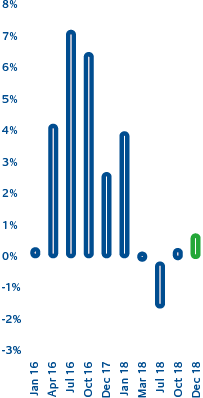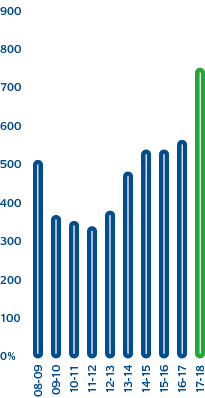Annual Report 2018
Your Partner for Growth
Afghanistan Economic Outlook
Significant export boosts from the agriculture sector and
far-reaching structural reforms are beginning to
stimulate the Afghanistan economy, with real GDP
growth showing an upward trend.
Afghanistan GDP annual growth rate (% pa)

Afghanistan inflation rate 2016 to 2018

Afghanistan exports 2009-2018 (US$ millions)

GDP annual growth rate in Afghanistan is reported by Da Afghanistan Bank | Source: Da Afghanistan Bank
Set against these negative trends, the economy is benefitting from the implementation of economic reforms and there are modest signs of growing confidence and momentum.
GDP
Afghanistan has experienced sluggish GDP growth since 2014 with an average annual rate of 2.7 percent. A number of factors have contributed to this including the withdrawal of US and international security forces, the deteriorating security situation over the past few years, reductions in international grants, and ongoing political uncertainty.
Set against these negative trends, the economy is benefitting from the implementation of economic reforms and there are modest signs of growing confidence and momentum. From a low of 1.5 percent in 2015, real GDP growth has accelerated to 2.9 percent in 2018 and continues to show an upward trend with real growth for 2019 projected at 3.1 percent.
Some important risks surround this projection, particularly around the upcoming presidential elections. However, these risks are balanced by significant upside potential if current peace talks with the Taliban can achieve success, thereby greatly improving the security and economic outlook. In aggregate, we expect real GDP to remain soft at between 3 percent and 5 percent over the next three years supported in particular by strengthening export volumes in agricultural and industrial sectors. Employment growth peaked at 2.9 percent in 2016, and is expected to remain flat at around 1 percent for the next three years.
Inflation
Inflation sat at 1.1 percent in December 2018, compared to an average inflation rate of 2.65 percent over the past three years. There has been some volatility in these figures, with a high of 7.37 percent in July 2016 and a low of 0.7 percent in January 2016. Between March and July 2018, deflationary conditions existed at a peak of -1.6 percent. Per capita income in 2018 was estimated at $620 per annum.
The agricultural sector continues to be a key driver of the economy, representing 23.7 percent of GDP and growing by 21.4 percent between 2016 and 2017.
Agricultural sector
The agricultural sector continues to be a key driver of the economy, representing 23.7 percent of GDP and growing by 21.4 percent between 2016 and 2017. This was a result of improvements in production techniques and facilities, as well as favourable weather conditions. With the majority of the population either directly or indirectly dependent on the sector, and as a fast-growing export category, the upward trend is a strong fillip for Afghanistan’s wider economy. Whilst government data on the growth rate for 2018 is not yet available, the observable sub-components indicate growth over the past 12 months has been even higher than in 2017.
Exports
The country’s exports in 2017/18 grew significantly to $784 million annually, compared to $571 million in 2015/16. Available data from Q1 2018 corroborates this growth, rising almost 50 percent against Q1 2017. Underlying improvements in infrastructure, such as the establishment of new air corridors to India, continue to drive exports and we expect further export growth.
The Kabul-New Delhi air corridor began in June 2017, followed by second air corridor (Kabul-Mumbai) in December 2018 through which over 100 flights have already been conducted between the two countries transporting 2,500 metric tons of goods. In the last three years, Kabul has exported about 10,200 metric tons of goods to India and trade between India-Afghanistan is predicted to reach $2 billion by 2020.
Pakistan remains the primary export destination for Afghan goods with 48 percent of exports, India (19 percent) and Russia (9 percent) are growing quickly, as are exports to Afghanistan’s regional neighbours and to China, Japan, Indonesia, and Malaysia.
Overall, exports currently account for around 20 percent of GDP. The primary categories are: carpets and rugs (45 percent); fresh and dried fruits (31 percent); and medicinal plants (12 percent).
Whilst continued growth is expected, a note of caution should be raised for 2019 given the upcoming presidential elections, as the previous presidential election in 2013/14 saw some disruption to export volumes.
Imports
2017/18 imports rose to $7,440 million from $6,534 million in 2016/17. However, indicators point towards import volumes dropping slightly in 2018, with Q1-Q3 imports totaling $5,282 million, indicating a likely reduction for the calendar year.
The country’s major imports are: petroleum (33 percent of total imports); machinery and equipment (15 percent), food items (14 percent) and base metals and related articles (9 percent).
The process of business reform has been a significant success for the country in 2018 with the World Bank highlighting the “extraordinary advancement” being made by Afghanistan.
The largest single source of imports is Pakistan, with 14 percent of total imports. Pakistan’s share of imports is however decreasing, with imports in the second half of 2018 falling to $608.533 million compared to $739.233 million for the same period in 2017. Year-on-year imports for December from Pakistan fell by 36.55 percent.
Lending
Bank lending to the private sector has been declining over the past five years. Lending for the first nine months of 2018 reached $572 million compared to $582 million for the 12 months of 2017.
That said, a significant rise in lending is not imminent as banks tighten credit standards ahead of presidential elections and the outcome of talks with the Taliban. Total bank deposits were $3.88 billion in December 2017, decreasing slightly to $3.62 billion in December 2018. Central bank reserves reserves increased from $8.11 billion at the end of 2017 to $8.24 billion in 2018.
Business reform
The process of business reform has been a significant success for the country in 2018 with the World Bank highlighting the “extraordinary advancement” being made by Afghanistan.
There have been significant reforms around: ease of starting a business; access to credit; taxation and collection; resolving insolvency; and protecting minority investors. In addition, the government departments responsible for all business licensing have now been gathered under a single umbrella, and indeed operate in the same building.
These steps have seen a remarkable boost for Afghanistan’s ranking in the World Bank’s Starting a Business Indicator — moving from 107th at the start of 2018 (below Djibouti) to 47th in January 2019 (above the USA).
A similarly strong performance in World Bank’s Resolving Insolvency rankings moved the country from 161st in 2018 to 74th at the start of 2019. The new insolvency framework should have a significant beneficial effect on the economy, with creditors more willing to enter the market. The framework puts in place a robust regime allowing reorganisations and liquidation; improving the continuation of the debtor’s business during insolvency proceedings; and improving the legal and institutional foundations for obtaining credit.
The Asian Development Bank and the World Bank continue to support the country’s national development projects in a wide range of sectors including: health; empowerment of women; transport; energy; natural resources; and economic management.
The country saw the corresponding Access to Credit ranking rise more modestly from 105th to 99th, but we would expect this to increase as creditors gain comfort with the new systems.
Further improvements to the investment climate would be welcome, with the attraction of foreign investment and promotion of domestic enterprise essential for the ongoing health of the economy.
Political outlook
The upcoming presidential election will be held in July 2019. A total of 18 candidates are registered including the current president Ashraf Ghani and his power-sharing CEO Abdullah Abdullah. Talks between the US and the Taliban have gathered momentum, despite the deterioration of the security situation in the country, with the new chief negotiator for the Taliban currently discussing a potential ceasefire with the US in Qatar. The proposed peace talks between the US and the Taliban are reportedly close to establishing a mechanism to bring conflict to an end. This would be a significant boost to the overall economic outlook.
Infrastructure
Due to a longstanding lack of dams, Afghanistan loses a significant proportion of its water resource to neighbouring countries, and severe droughts are a common occurrence for the majority of the country’s provinces. This causes problems for the important agricultural sector, which in turn creates food shortages and displacement of population.
President Ashraf Ghani guaranteed in his early days as president to build 26 dams to conserve water. Construction has commenced on most of these dams, which will safeguard water requirements for agriculture as well as help satisfy domestic electricity needs. The potential inclusion of Afghanistan in CPEC and Asian Development Bank grants in the energy sector will provide further impetus for this development.
President Ghani inaugurated the Lapis Lazuli Corridor Accord at the end of 2018, providing Afghanistan with a direct transport link for Europe via road, rail and sea. Goods will be transported through Turkmenistan, across the Caspian Sea to Azerbaijan and Georgia, then across the Black Sea and through Turkey to the Mediterranean and Europe.
Looking east, Afghanistan has many trade gates opening toward central Asia and its international markets. Both Indian and Chinese companies are playing an increasing role in Afghanistan, with China actively investing in the country to foster commercial ties. This is especially evident in the construction of railways, dams, roads and housing, and through imports of Afghan hygiene products. The Sino-Afghan Special Railway Transportation project connects Afghanistan to China’s ‘One Belt, One Road’ trade corridor with Uzbekistan, Kazakhstan and Iran.
Development support
The Asian Development Bank and the World Bank continue to support the country’s national development projects in a wide range of sectors including: health; empowerment of women; transport; energy; natural resources; and economic management. To date, the World Bank has committed more than $4.1 billion to these development projects. The World Bank administered Afghanistan Reconstruction Trust Fund has raised more than $10.6 billion, and the country has secured financial commitment from the international donor communities for the next five years, with $3.5 billion per year pledged at the Brussels conference 2016. The government also receives a similar level of annual assistance from Tokyo ($3.9 billion per year). These international partners reconfirmed their long-term support for the country at a NATO summit in 2018.
